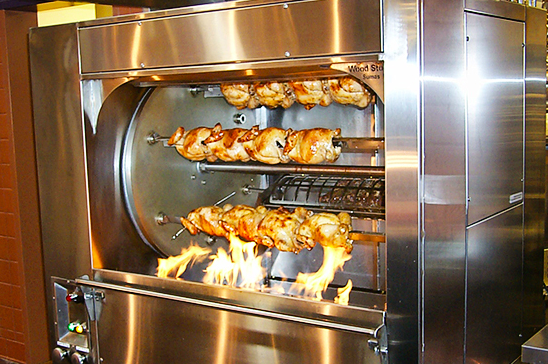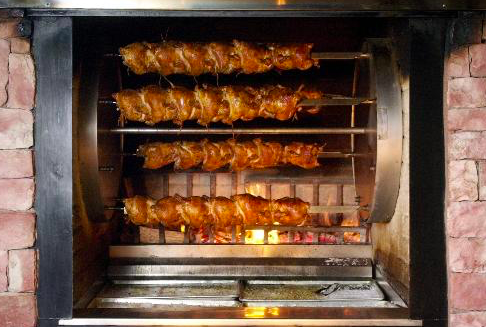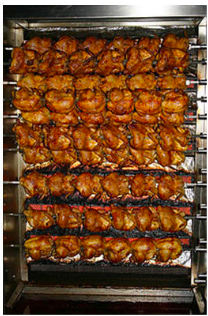Searching for a used commercial grade rotisseries oven for your catering business, restaurant, or quick serve concept? We’ve got you covered with affordable prices on all sorts of used restaurant equipment. All our inventory is listed directly by owner. We don’t take any listing fees or commissions, meaning we are able to offer the price prices possible on used rotisserie ovens. Browse our active listings below to find your next oven at a steep discount over new equipment.
[display_listings l_type=”95″]
Introduction

If you’re wondering about whether it’s worth adding a commercial rotisserie oven to your kitchen operation, talk to the folks at Boston Market. They’ve built an entire brand around the ready-to-serve roast chicken market, to the tune of hundreds of millions of dollars in sales. Or for that matter, talk to the owners of any supermarket, convenience store, restaurant, catering business, or big-box membership wholesale club store about how profitable their rotisserie ovens have been. Americans buy 625 million rotisserie chickens per year; Costco alone sells almost 90 million of the roasted, seasoned birds annually.
“Rotisserie cooking” (or sometimes, “spit-cooking,” though some of the connotations of this term make it less popular) refers to taking any raw cut of meat (or even a whole animal, such as a chicken or a pig), placing it through on a skewer or spit, and rotating it slowly over a heat source. This constant movement and rotation allows the meat to cook evenly, basting itself in its own fat and juices as it moves.
If this sounds like some real caveman stuff, that’s probably because it is. Stabbing a dead animal with a big stick and then turning it slowly over a fire is a cooking method the reaches back to ancient times, updated using today’s modern technology to produce an inexpensive, high-margin, consistent product that’s well-suited for sales in restaurants, grocery stores, and convenience stores.
What Can I Cook in a Used Commercial Rotisserie Oven?

Used commercial rotisserie ovens come in a wide variety of shapes and sizes, each uniquely suited to different applications. Depending on what you plan to cook, you can find different-sized rotisseries for chicken and pigs, in-ground rotisseries, table top rotisseries, electric, gas or even commercial charcoal rotisseries. To figure out what kind of commercial rotisserie oven is right for you and your business, begin by figuring out exactly what you plan to cook in your new oven, since this will be the biggest determining factor in how much oven you need. Chicken is the most common, but legs of lamb, fish, ribs, beef roasts, and even some types of vegetables threaded onto skewers can all be cooked in rotisserie ovens.
Next, consider the different features that different rotisserie ovens bring; power source is an important part of the decision making process (more on this later). The capacity of the oven is important; you’ll want to make sure you can cook enough food to meet customer demand, while avoiding food waste or running the rotisserie less than fully loaded, which wastes energy. Make sure to choose a rotisserie oven that’s the size and shape that makes the most sense for your application; a rotisserie oven that’s being placed in a giant restaurant kitchen is going to be a different size and shape than one that’s being placed in a food truck or concession trailer.
The final deciding factor for most of us will probably be cost. If purchased new, small countertop commercial rotisserie ovens start at about $2,000, with the price quickly climbing to $20,000 or more for gigantic, free-standing floor models which can cook upwards of 50 whole chickens at a time. Make the decision to buy used, however, and you can slash those prices in approximately half…if you know what to look for.
Which Power Source Should I Be Shopping For?

There are three main categories for used commercial rotisserie ovens: Electricity, natural gas, and liquid propane (or LP). Each type of heating technology comes with its own set of advantages and disadvantages, and ovens which perform well in some environments may not be a good fit for others. Let’s take a look at some of the pros and cons of each cooking type, while also taking utility cost into account. Remember, these overviews are just meant as a guideline; prices on natural gas, electricity, and propane vary from region to region, and you may find that one type of utility makes more financial sense than another, depending on where you live.
Natural gas rotisserie ovens are generally capable of the highest consistent cooking temperatures, which means food cooks faster and more efficiently. They also require less service and maintenance, since they don’t include expensive heating bulbs that need constant replacing. However, natural gas ovens aren’t always great at maintaining precise cooking temperatures, particularly at the low range, which makes them less well suited for barbecue or other “low and slow” styles of cooking.
Electric rotisserie ovens seem to offer the best precise temperature control, including both the range of temperatures possible and the degree to which they cook food evenly. Remember that electric ovens don’t typically offer the same high temperatures as natural gas or propane ovens, however, so cooking may take longer. Electric ovens also typically use heating bulbs, which carry the one-two punch of being both very expensive, and very fragile. This makes ongoing maintenance more of an issue in these types of ovens.
Propane rotisserie ovens offer one major advantage over natural gas or electric ovens: Portability. We know, we know, your restaurant is going to last forever and NEVER go out of business, but if you reach a point where you need to sell some equipment, having a portable oven makes moving it much easier. Quasi-mobile propane rotisseries are easier to install (provided your location has a propane line already in place), and a perfect match for mobile or catering businesses that need to set up and produce fresh food in remote locations.
How Do I Evaluate a Used Commercial Rotisserie Oven?

Whether you’re outfitting a new commercial kitchen in your dream restaurant, or replacing an existing commercial rotisserie oven that’s gone belly-up, shopping for used equipment can be a good place to stretch your purchasing budget. Unlike some types of commercial cooking equipment, which tend to be used harder and take more abuse, rotisserie ovens that have been treated with even a basic amount of care will continue performing just as well as their more expensive, brand-spanking-new counterparts. While buying a used oven may not give you the satisfaction of peeling the protective film off a new stainless steel surface, or may lack some advanced features (like digital controls or increased energy efficiency), most used commercial rotisserie ovens still cook beautifully.
Of course, when buying a used commercial oven, you do run the risk of experiencing a breakdown or needing maintenance sooner than with a new oven. Newer ovens tend to have more technologically advanced features which may be convenient, but which also makes them more prone to breakdown. In a used rotisserie oven, the mechanism most prone to breakdown is the rotation of the spits; check to make sure that all spits are rotating freely.
If your planned installation environment will allow it, we recommend looking for propane or natural gas-fired ovens (if your kitchen setup will provide for gas appliances), since these tend to have a simpler design, be less prone to breakdown, and less costly to repair than their electric counterparts.
Check to make sure the oven door (or doors, in some models) is closing freely and properly. Check for a tight seal around the oven door, and beware of rubber seals that appear dried out, cracked, or pitted. Invest in an infrared thermometer, which will allow you to take instant readings of the inside of the oven. While all ovens contain some amount of both “cool” and “hot” spots, remember that the goal of rotisserie cooking is smooth, even heat, so look for models which heat as consistently as possible.
While you’ve got your infrared thermometer out, check to make sure that the temperature readout on the dial or digital display matches what’s going on inside the cooking chamber; we’ve seen ovens where the temperature can be off by as much as fifty degrees, which can cause a lot of unwanted surprises in a busy commercial kitchen. Remember that the temperature readout on the display or knob can usually be calibrated inside the oven itself, so if the temperatures don’t match, check that before deciding whether or not to pass on the sale.
In many establishments, the visual impact of a rotisserie oven humming away, roasting dozens of chickens at a time is part of the appeal and part of what drives sales, so look for an oven that’s in as good a physical condition as possible. If your oven isn’t going to be in view of your customers, remember: An oven that looks like a mess, but which provides quick, consistent, even heat is preferable to a shiny, cosmetically perfect oven with all of the bells and whistles, but which can’t hold a temperature.
If something doesn’t seem to be working right with the used commercial oven you are considering, or if there are known problems with the oven, contact the manufacturer prior to closing the deal to check on the replacement price of parts that are prone to failure. You may be able to negotiate an amazing price on an oven that the current owner thinks of as “broken,” if you’re willing to have it repaired yourself inexpensively.
